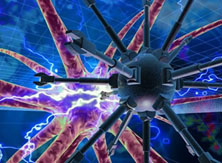Researchers Develop Chemo-Magnetic Controlled Self Propelled Microbots

 Nature has created a variety of sophisticated ATP-powered motor proteins which converts chemical energy into mechanical work and plays essential role in cellular transport and motility. The existence of efficient biological motors in nature has inspired scientists to design chemically-powered synthetic motors. These self-propelled nano and micromachines have been designed to operate in locally-supplied chemical fuels and perform various functions in the micro/nanoworld ranging from targeted drug delivery to biosensing.
Nature has created a variety of sophisticated ATP-powered motor proteins which converts chemical energy into mechanical work and plays essential role in cellular transport and motility. The existence of efficient biological motors in nature has inspired scientists to design chemically-powered synthetic motors. These self-propelled nano and micromachines have been designed to operate in locally-supplied chemical fuels and perform various functions in the micro/nanoworld ranging from targeted drug delivery to biosensing.
Extending the scope of artificial micromotors for diverse applications, Dr. Bandyopadhyay and his team at the Indian Institute of Technology Guwahati, India have reported magnetically controlled-propulsion of catalytic microbots towards a specific target in response to an imposed alkali gradient. Their work has been described recently in the journal Nanoscale (DOI: 10.1039/C3NR05294J).
When a FeNP coated micromotor was immersed inside a bath of diluted peroxide solution and a pH gradient was imposed inside the bath by introducing alkali (sodium hydroxide), the motor detected the alkali-rich zone and intelligently migrated towards the alkali source. The self-propulsion of an iron nanoparticle (FeNP) coated polymer micromotor was achieved by asymmetric decomposition of hydrogen peroxide fuel due to the presence of iron nanoparticles over the motor surface. The heterogeneous catalytic decomposition of the peroxide was clearly visible as the bubbles emanated from the motor’s surface. The driving force for the motion towards the alkali source was the solute pressure imbalance across the micromotor caused by the surface decomposition of peroxide fuel, magnified by the global solute concentration gradient created due to the self-depletion of the peroxide fuel in the presence of alkali gradient. The experiments also showed that when the motor was further away from the alkali source (in a region of lower pH), it moved with a uniform speed whereas as it approached the thread connected to a reservoir of NaOH, it accelerated significantly in a region of higher pH.
The motile micro-organisms undergo chemotaxis of a few micrometers per second but in this case the sole influence of the alkali gradient could move the motor as high as 25 body lengths per second, which was further amplified by external magnetic field. The influence of the coupled internal and external fields could halt, steer or reverse the direction these versatile and sensory autonomous microbots inside a microchannel, rotate the motor around a target, and deliver the motor to a cluster of cells. This study showcases a multimodal chemical-magnetic field regulated migration of micro-machines for sensing, transport, and delivery inside a fluidic environment.
The cytotoxin of bacterium Helicobacter pylori increases alkaline secretion in gastric epithelial cells. In near future, Dr. Bandyopadhyay and his team plan to improve these microbots for sensing high alkali concentration across the Helicobacter pylori-infected gastric cells in vivo and subsequently locate and destroy the infected cells and pathogens with therapeutic payloads.
About the author:
 Amit Kumar Singh is currently pursuing Ph.D. at Center for Nanotechnology, Indian Institute of Technology Guwahati, India. His current research is primarily focused on developing self-propelling and field driven synthetic micro/nano motors for therapeutics. Previously, He has completed B.Tech and M.Tech in Biotechnology from Heritage Institute of Technology, Kolkata, India. His research interests are nanoscale motion control and nanobiotechnology.
Amit Kumar Singh is currently pursuing Ph.D. at Center for Nanotechnology, Indian Institute of Technology Guwahati, India. His current research is primarily focused on developing self-propelling and field driven synthetic micro/nano motors for therapeutics. Previously, He has completed B.Tech and M.Tech in Biotechnology from Heritage Institute of Technology, Kolkata, India. His research interests are nanoscale motion control and nanobiotechnology.
